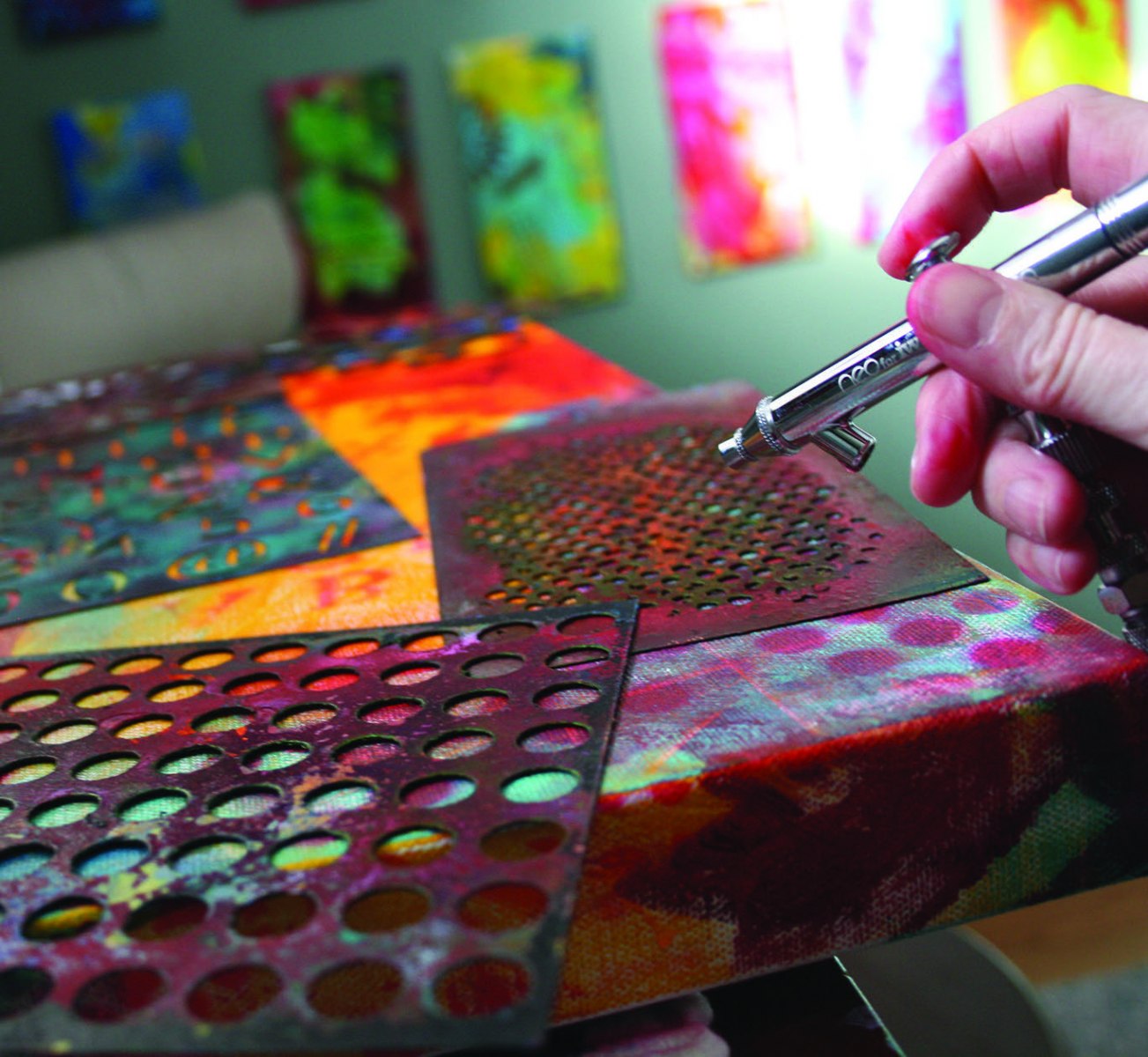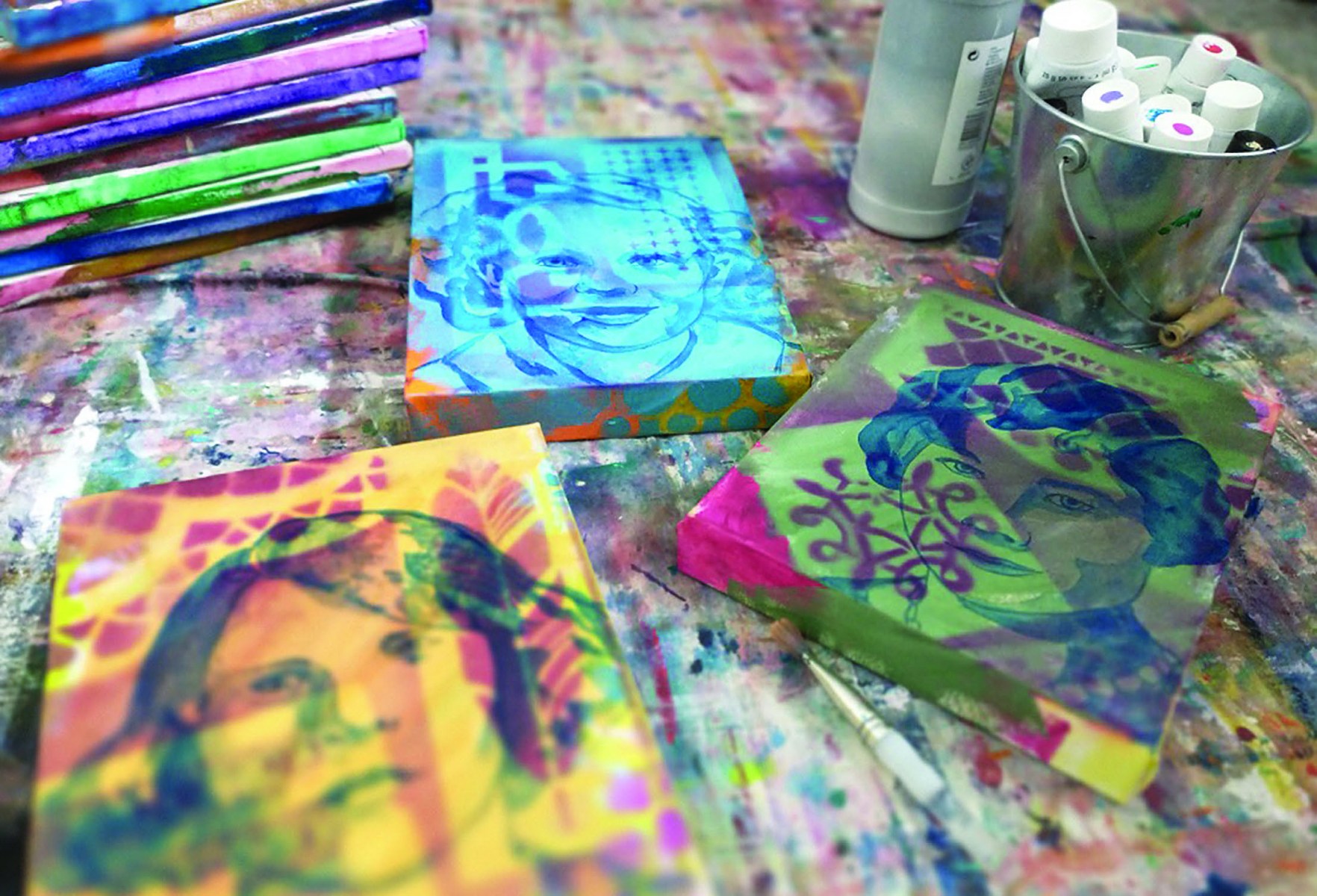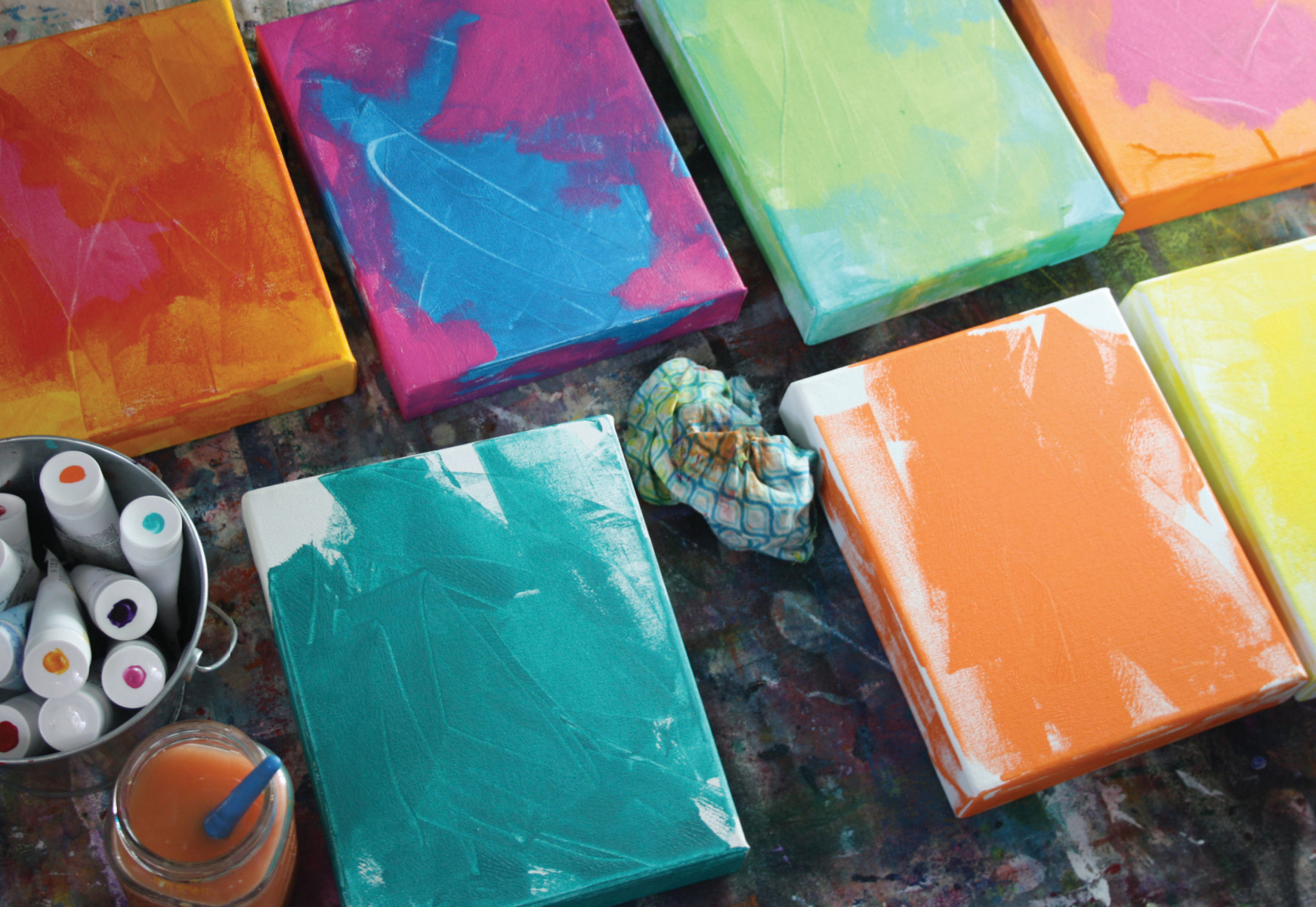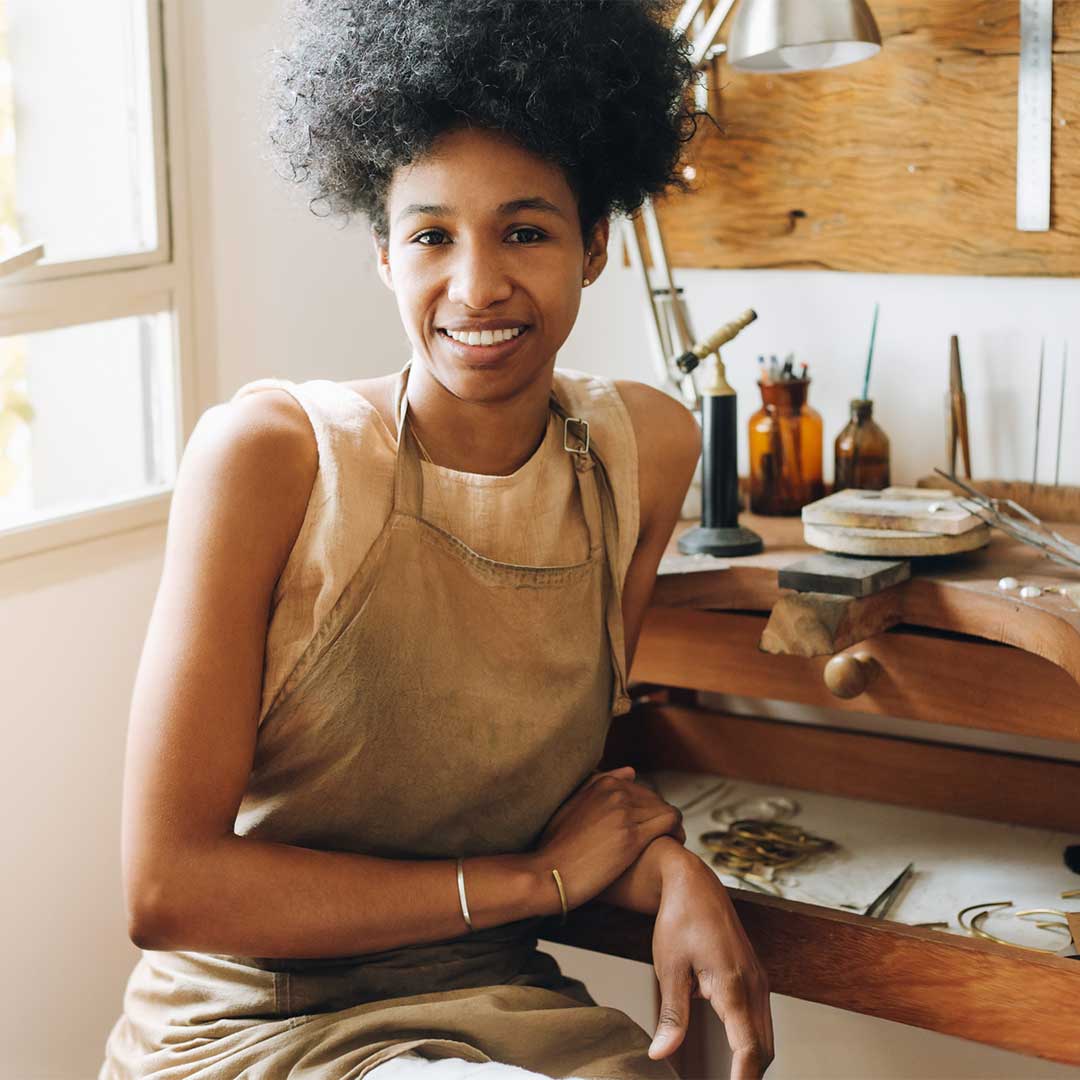Many years ago, while attending art college, I remember being told of the importance of creating a body of work in order to improve my skills and also to recognize accomplishments but it wasn’t until years later, in 2013, that I began my first 52 WEEKS project. I prepared canvases and hung them on the wall so that each week as I added a new painting on top of the base, I would be reminded of what I had completed. It also inspired me to keep going. My focus with these projects was to experiment with mixed media and with painting subject matter that I wasn’t very comfortable with in order to stretch my creative muscles. Every week I painted a small painting as I hadn’t drawn or painted in this manner since college. In order to create a sense of accountability which I knew I would need to keep me working, I posted my completed painting online each Monday. In the past my work had consisted of large paintings, but I found that taking a little step to work on a small canvas each week to create something bigger ended up being extremely gratifying. I learned so much about myself and developed a stronger personal creative style because of the work that I was completing weekly. During the project there were times that I felt I should quit believing my skillset wasn’t good enough, but because of the encouragement I received both online and in person I kept going.

Though I know that staying committed to something can be challenging, it is also very rewarding. There has been the odd project that I have given up on when I realized that I didn’t connect with the subject matter, even when I thought the idea was good. With each new project, there are the ebbs and flows. I wonder if I’m talented enough to do justice to the work or if my idea is even worth pursuing, but I usually persevere, knowing that if I feel really strongly about an idea, it is worth the struggle. After overcoming that challenge in my first undertaking, which did feel a bit overwhelming at times, I recognized that I could do it. With each consecutive project, I have felt the same sense of struggle at about the same period into the work, but knowing I did it once, definitely helped me do it again. Being surrounded by my work on the walls of my studio while completing each piece also helped. There is an energy that comes from a collection of work that is empowering.

Even after completing and exhibiting my work numerous times throughout the years, I still question myself. I wonder if I’m good enough but then remind myself to focus on the process and not the end results. I think that was a lesson I was taught as a young girl growing up in northern Canada where I learned weaving and beading and embroidery from a group of wonderful ladies. They showed us the importance of slowing down and enjoy what we were doing.

I tend keep a small sketchbook with me, where I jot down or create thumbnail sketches of ideas. As I pay attention to what draws my attention, these ideas slowly grow until they become a new project. The first 52 WEEKS project featured animals on mixed media grounds as I wanted to experiment with new media while improving my drawing and painting skills. Another project titled ‘Heroes’ featured women who inspired my daughters and, as I hadn’t painted portraits since college, I was determined to paint inspiring women. Yet another project included portraits of 100 women over 100 days because I believe the women in our daily lives inspire so many. Currently my goal is to paint strong women who, through their vulnerability and honesty encourage others.

While going through old family photographs in the fall of 2019, I began to wonder how I could honour those women who came before us. I loved the idea of honouring what our grandmothers have done, often without recognition, so for 52 weeks beginning in January 2020 I began creating a body work consisting of weekly portrait paintings based on photographs and stories that were shared with me. My goal was to include female ancestors and to honour their stories in order to share the challenges and successes of these women. There is strength in in these collaborative projects as those who shared their grandmothers with me also encouraged me to continue throughout the year. As the Covid-19 pandemic hit worldwide during this process, I found ‘The Grandmothers’ project to be even more important. So many women survived world wars, droughts, poverty, violence and illness. They were uprooted from their families and still found a way to support and encourage their families and neighbours.

Every day that I entered my studio, I was encouraged by the faces and stories of these women. With this project I wanted to share the beautiful, strong, encouraging women who have made a difference in the lives of others, through their portraits and through sharing their stories and memories of their sacrifices and how they overcame their own challenges. They give me hope.
PROCESS:
Since I tend to find a blank canvas to be quite intimidating, I found that in my work I prefer to begin by creating a base that resembles graffiti or street art as the layers of color and pattern remind me of layers of history and bring the portraits to life. Each of these projects began with layers of vibrant color and pattern, created by utilizing palette knives, brayers and stencils. In order to keep the colors vibrant, each layer of color is allowed to dry thoroughly in between applications.
Though in my first project I prepared a canvas a week as I worked, I now tend prepare the bases on the entire series of canvases in order to hang them in my studio so that I can watch the series progress. In the beginning I also used a sponge to apply pattern using the stencils, then began to incorporate to spray paint, and now use an airbrush with acrylic inks that I often mix myself using dry pigments, airbrush thinner and acrylic paint. Some of my stencils have been purchased while others were created using a marker, a sheet of plastic or cardboard and an X-acto knife. I find inspiration for stencils everywhere, from the sparrows that fly outside my windows to patterns in curtains and wallpaper. Using a sheet of plastic is especially nice as the patterns can be traced directly onto the surface, are easily cut out and then can be used for many years.
Once the base has dried well, I often mix a transparent wash of acrylic paint, or pigments which are finely ground natural earth mixed into equal parts of acrylic flow medium, glazing medium and water, in order to begin adding a base of shadows to the portrait. My favourite colors for this layer are alizarin crimson, dioxazine magenta, dioxazine purple and pthalo or Prussian blue as they are all translucent and create interesting layers for skin tones.
This process of layering transparent colour is similar to working with watercolors. I also to keep a rag handy while I draw a portrait onto my canvas using this transparent mixture and a brush so that while the glaze is still wet, I can wipe away any of the lines and shadows that don’t reflect the photograph of the person I’m drawing on my canvas. Holding the photo and canvas up to a mirror helps my eyes to ‘see’ errors. I also like to photograph the painting with my cell phone and flip the image to see areas that need adjusting or to change the photograph to black and white to see the contrast between light and dark.
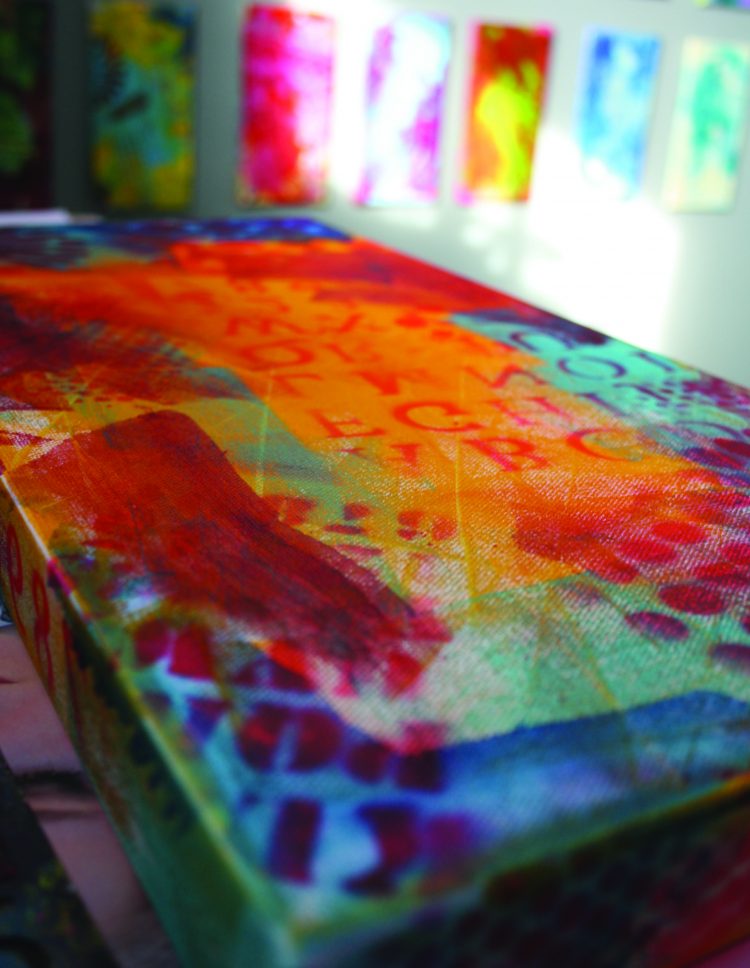
After allowing this layer to dry, I then go back into the initial drawing in order to darken shadows or lines then, once this layer has dried, I like use mixtures of titanium white, burnt umber, alizarin crimson, cadmium free yellow or orange to create highlights. After this layer has dried, I continue with mid tones, using the same mixtures while reducing or completely removing any of the titanium white that was added. After drying for at least one day, I often go back into the work to increase the shadows using the blue or purple glaze that was used for the initial shadows or increase overall color with a glaze of alizarin crimson wiped back in highlighted areas. These layers add warmth and personality to the painting.

Often the base layers of stencil patterns and colours will show through the final portrait, which I think adds interest to the final piece. There is something so wonderful about looking closely at a painting and seeing something new every time. The stencils I use in the base layers reflect something that I find important about the subject…such as incorporating letters and numbers for a teacher or fabric patterns for a seamstress. I also ask people to share favourite colours, symbols and stories so that these personal mementos and memories can be incorporated. The background, for me, is as important as the portrait.

In the case of ‘The Grandmothers’ project, I was privileged to learn the most wonderful stories about each of these women. So many of them were educated or found employment without any support. They raised families in difficult situations, contributed to the war effort in many different ways, and supported their communities in times of illness and drought. I was privileged to be entrusted with this work.

“If you are wise, you will show yourself rather as a reservoir than as a canal. A canal spreads abroad water as it receives it, but a reservoir waits until it is filled before overflowing, and thus without loss to itself shares its super abundant water.” ~ Bernard of Clairvaux, Celtic Monk
Many years ago, while attending art college, I remember being told of the importance of creating a body of work in order to improve my skills and also to recognize accomplishments but it wasn’t until years later, in 2013, that I began my first 52 WEEKS project. I prepared canvases and hung them on the wall so that each week as I added a new painting on top of the base, I would be reminded of what I had completed. It also inspired me to keep going. My focus with these projects was to experiment with mixed media and with painting subject matter that I wasn’t very comfortable with in order to stretch my creative muscles. Every week I painted a small painting as I hadn’t drawn or painted in this manner since college. In order to create a sense of accountability which I knew I would need to keep me working, I posted my completed painting online each Monday. In the past my work had consisted of large paintings, but I found that taking a little step to work on a small canvas each week to create something bigger ended up being extremely gratifying. I learned so much about myself and developed a stronger personal creative style because of the work that I was completing weekly. During the project there were times that I felt I should quit believing my skillset wasn’t good enough, but because of the encouragement I received both online and in person I kept going.

Though I know that staying committed to something can be challenging, it is also very rewarding. There has been the odd project that I have given up on when I realized that I didn’t connect with the subject matter, even when I thought the idea was good. With each new project, there are the ebbs and flows. I wonder if I’m talented enough to do justice to the work or if my idea is even worth pursuing, but I usually persevere, knowing that if I feel really strongly about an idea, it is worth the struggle. After overcoming that challenge in my first undertaking, which did feel a bit overwhelming at times, I recognized that I could do it. With each consecutive project, I have felt the same sense of struggle at about the same period into the work, but knowing I did it once, definitely helped me do it again. Being surrounded by my work on the walls of my studio while completing each piece also helped. There is an energy that comes from a collection of work that is empowering.

Even after completing and exhibiting my work numerous times throughout the years, I still question myself. I wonder if I’m good enough but then remind myself to focus on the process and not the end results. I think that was a lesson I was taught as a young girl growing up in northern Canada where I learned weaving and beading and embroidery from a group of wonderful ladies. They showed us the importance of slowing down and enjoy what we were doing.

I tend keep a small sketchbook with me, where I jot down or create thumbnail sketches of ideas. As I pay attention to what draws my attention, these ideas slowly grow until they become a new project. The first 52 WEEKS project featured animals on mixed media grounds as I wanted to experiment with new media while improving my drawing and painting skills. Another project titled ‘Heroes’ featured women who inspired my daughters and, as I hadn’t painted portraits since college, I was determined to paint inspiring women. Yet another project included portraits of 100 women over 100 days because I believe the women in our daily lives inspire so many. Currently my goal is to paint strong women who, through their vulnerability and honesty encourage others.

While going through old family photographs in the fall of 2019, I began to wonder how I could honour those women who came before us. I loved the idea of honouring what our grandmothers have done, often without recognition, so for 52 weeks beginning in January 2020 I began creating a body work consisting of weekly portrait paintings based on photographs and stories that were shared with me. My goal was to include female ancestors and to honour their stories in order to share the challenges and successes of these women. There is strength in in these collaborative projects as those who shared their grandmothers with me also encouraged me to continue throughout the year. As the Covid-19 pandemic hit worldwide during this process, I found ‘The Grandmothers’ project to be even more important. So many women survived world wars, droughts, poverty, violence and illness. They were uprooted from their families and still found a way to support and encourage their families and neighbours.

Every day that I entered my studio, I was encouraged by the faces and stories of these women. With this project I wanted to share the beautiful, strong, encouraging women who have made a difference in the lives of others, through their portraits and through sharing their stories and memories of their sacrifices and how they overcame their own challenges. They give me hope.
PROCESS:
Since I tend to find a blank canvas to be quite intimidating, I found that in my work I prefer to begin by creating a base that resembles graffiti or street art as the layers of color and pattern remind me of layers of history and bring the portraits to life. Each of these projects began with layers of vibrant color and pattern, created by utilizing palette knives, brayers and stencils. In order to keep the colors vibrant, each layer of color is allowed to dry thoroughly in between applications.
Though in my first project I prepared a canvas a week as I worked, I now tend prepare the bases on the entire series of canvases in order to hang them in my studio so that I can watch the series progress. In the beginning I also used a sponge to apply pattern using the stencils, then began to incorporate to spray paint, and now use an airbrush with acrylic inks that I often mix myself using dry pigments, airbrush thinner and acrylic paint. Some of my stencils have been purchased while others were created using a marker, a sheet of plastic or cardboard and an X-acto knife. I find inspiration for stencils everywhere, from the sparrows that fly outside my windows to patterns in curtains and wallpaper. Using a sheet of plastic is especially nice as the patterns can be traced directly onto the surface, are easily cut out and then can be used for many years.
Once the base has dried well, I often mix a transparent wash of acrylic paint, or pigments which are finely ground natural earth mixed into equal parts of acrylic flow medium, glazing medium and water, in order to begin adding a base of shadows to the portrait. My favourite colors for this layer are alizarin crimson, dioxazine magenta, dioxazine purple and pthalo or Prussian blue as they are all translucent and create interesting layers for skin tones.
This process of layering transparent colour is similar to working with watercolors. I also to keep a rag handy while I draw a portrait onto my canvas using this transparent mixture and a brush so that while the glaze is still wet, I can wipe away any of the lines and shadows that don’t reflect the photograph of the person I’m drawing on my canvas. Holding the photo and canvas up to a mirror helps my eyes to ‘see’ errors. I also like to photograph the painting with my cell phone and flip the image to see areas that need adjusting or to change the photograph to black and white to see the contrast between light and dark.

After allowing this layer to dry, I then go back into the initial drawing in order to darken shadows or lines then, once this layer has dried, I like use mixtures of titanium white, burnt umber, alizarin crimson, cadmium free yellow or orange to create highlights. After this layer has dried, I continue with mid tones, using the same mixtures while reducing or completely removing any of the titanium white that was added. After drying for at least one day, I often go back into the work to increase the shadows using the blue or purple glaze that was used for the initial shadows or increase overall color with a glaze of alizarin crimson wiped back in highlighted areas. These layers add warmth and personality to the painting.

Often the base layers of stencil patterns and colours will show through the final portrait, which I think adds interest to the final piece. There is something so wonderful about looking closely at a painting and seeing something new every time. The stencils I use in the base layers reflect something that I find important about the subject…such as incorporating letters and numbers for a teacher or fabric patterns for a seamstress. I also ask people to share favourite colours, symbols and stories so that these personal mementos and memories can be incorporated. The background, for me, is as important as the portrait.

In the case of ‘The Grandmothers’ project, I was privileged to learn the most wonderful stories about each of these women. So many of them were educated or found employment without any support. They raised families in difficult situations, contributed to the war effort in many different ways, and supported their communities in times of illness and drought. I was privileged to be entrusted with this work.

“If you are wise, you will show yourself rather as a reservoir than as a canal. A canal spreads abroad water as it receives it, but a reservoir waits until it is filled before overflowing, and thus without loss to itself shares its super abundant water.” ~ Bernard of Clairvaux, Celtic Monk











